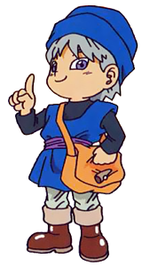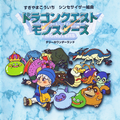Dragon Quest Monsters: Difference between revisions
m (→Leveling up) |
m (→Leveling up) |
||
| Line 42: | Line 42: | ||
===Leveling up=== | ===Leveling up=== | ||
[[File:DQM Terry.png|right|border| | [[File:DQM Terry.png|right|border|150px]] | ||
Just like in most RPGs, monsters are able to gain EXP (Experience Points) and level up. Each monsters' requirements for EXP to level up varies, depending on their plus number or even what monster family they belong to. When they level up, they gain stats and sometimes skills if they are at a suffcient level with the sufficient stats that are required to unlock the skil. All monsters can carry a maximum of eight skills; if a monster can gain more than eight skills you have the option of replacing old skills with new ones. | Just like in most RPGs, monsters are able to gain EXP (Experience Points) and level up. Each monsters' requirements for EXP to level up varies, depending on their plus number or even what monster family they belong to. When they level up, they gain stats and sometimes skills if they are at a suffcient level with the sufficient stats that are required to unlock the skil. All monsters can carry a maximum of eight skills; if a monster can gain more than eight skills you have the option of replacing old skills with new ones. | ||
Revision as of 14:14, 5 August 2016
| Spinoff games | |
|---|---|
| Dragon Quest Monsters | |
| File:DWM Box.png | |
| Developer(s) | TOSE |
| Publisher(s) | JP Enix NA Enix/Eidos Interactive |
| Designer(s) | Yuji Horii |
| Series | Dragon Quest Monsters |
| Platform(s) | Game Boy Color, mobile phones |
| Release date(s) | JP September 25, 1998 NA December 31, 1999 EU 1999 |
| Genre(s) | Console role-playing game |
| Mode(s) | Single-player, multiplayer |
| Rating(s) | ELSPA: 3+ ESRB: E (Everyone) |
| Media | 16 megabit Game Boy Color cartridge, backwards compatible with Game Boy |
Dragon Quest Monsters (titled Dragon Warrior Monsters for the US release) is the first game in the Dragon Quest spin-off series, Dragon Quest Monsters. Released for the Nintendo Game Boy Color in 1999, It stars a young Terry from Dragon Quest VI as the hero.
Whereas most game in the series focus on the adventures of a hero rising up against the forces of darkness, DQM is the much smaller-scale story of a little boy and girl, Terry and Milly, characters from Dragon Quest VI, when they were just small children. It opens with Milly's kidnapping by an evil creature called Warubou, after which another called Watabou appears, explains the situation, and starts Terry off on his quest to rescue his sister.
DQM took the monster-recruitment elements of Dragon Quest V and expanded upon them, also borrowing a few mechanics from the Pokemon series, setting the standards for what would become the "Dragon Quest Monsters series." The basic concept is that Terry, as a young boy still too weak to fight for himself, must enlist the help of various creatures to act in his stead. Collected monsters level up and grow like a character in a main-series Dragon Quest game might. As he progresses, he is able to add more and stronger monsters to his collection, which stands in for usual Dragon Quest power escalation elements such as steadily strengthening spells.
It generally makes quite good use of DQ staples already in place, such as character growth through battling, Travel Gates, the Monster Arena, Tiny Medals, and general progression.
Breeding is one of the game's most complicated and involving aspects, and one of the player's primary motivations for continuing to play, even after having seen the ending.
Story
The game begins with young Terry and Milly living peacefully in their house, in the days before Dragon Quest VI, when Terry and Milly were just children. When they go to bed at night, Terry gets up and goes into the next room. A strange monster then appears from a dresser looking for Milly and kidnaps her and then vanishes back from the dresser he came from. Soon after, another monster, similar to the kidnapper, appears from the same dresser looking for Milly but is surprised to learn that she has already been taken away. The monster, Watabou, then asks Terry if he would like to find out where his sister and the kidnapper are and to follow him to the Kingdom of GreatTree. Watabou and Terry both go into the dresser and Terry then finds himself in an unknown land. He meets the king and receives Slib the slime, his first monster to train. If Terry wins the Monster Trainer's Starry Night Tournament, he will be granted a wish. So Terry sets out with his team to explore the many monster dungeons to win the tournament and rescue his sister.
Gameplay
Breeding
After beating Class F in the Arena, the player can breed monsters if they are at level 10 or above at the Shrine of Starry Night, which is taken care of by the current Master Monster Tamer. Breeding requires one male and one female monster. The result of the breeding will be an egg, containing a level 1 monster which has characteristics of both parents, including skills and stats. The egg can then be left in the monster farm or hatched, which costs a small fee. The monster born will have a plus number next to it, the number generally signifying the greatness of the monster's stats, the higher being the better. It costs more money to hatch a monster with a higher plus number than one with no plus number. Also, the number beside the plus multiplied by two is added to the limit for the maximum level for the monster.
Genders
Once the Egg Evaluator is available for use, eggs can have the gender of the monster they're containing checked and changed. Both requires a small fee which is paid to the Egg Evaluator. The fee increases depending on the monster's plus number.
Monster Farm
A storage place for your monsters, where they can be picked up or dropped off. There is an option to put monsters at the farm to sleep, which allows them to maintain their wilderness level and allows the player to keep an additional 19 monsters but they will not gain experience or grow in level unlike non-sleeping monsters who do. There can be 19 awake and 19 asleep monsters at any one time.
Leveling up
Just like in most RPGs, monsters are able to gain EXP (Experience Points) and level up. Each monsters' requirements for EXP to level up varies, depending on their plus number or even what monster family they belong to. When they level up, they gain stats and sometimes skills if they are at a suffcient level with the sufficient stats that are required to unlock the skil. All monsters can carry a maximum of eight skills; if a monster can gain more than eight skills you have the option of replacing old skills with new ones.
Travelers' Gates
The player moves around to other worlds through warp gates, called travelers' gates in-game, which are located underneath the throne room. To access these gates, the player needs to defeat a class ranking. There are a certain number of areas in a world and at the last one, the player needs to defeat a boss. Other gates are hidden throughout Great Tree, such as one in the library that is only accessible after befriending over 100 different monsters.
Bosses
Players of other games in the Dragon Quest series will recognize many of the bosses and boss levels. Examples include the Golem guarding the town of Mercado and the Dragon holding Princess Gwaelin captive (both from the original Dragon Quest). Some bosses in the game offer to join the player's party automatically, some have to be won over with meat, and some will not join at all.
Arena Battles
In this game the player goes through ranks that consists of three different battles that must be won before the player can advance to the next ranking. Each rank provides harder challenges: the higher the rank, the harder the monsters. The battles you able to start at are from Rank G and go to Rank D and later in the game you are able to go from Rank C to Rank A and then Rank S. These battles open up gates for the character to explore and are necessary to progress through the story. The arena battles cost gold to enter:
Rank G: No fee
Rank F: 10G
Rank E: 50G
Rank D: 100G
Rank C: 500G
Rank B: 1000G
Rank A: 5000G
Rank S: 10000G
Starry Night Tournament: No fee
Tiny Medals
These medals are scattered throughout different worlds and are randomly picked up. In the game, there is a man who largely resembles the king located east of the Monster Arena who will give the following eggs for the cumulative number of Tiny medals brought to him in the original Game Boy game:
13 Medals: ZapBird
18 Medals: Trumpeter
25 Medals: Spikerous
30 Medals: Metabble
Foreign Masters
While in other worlds, the player can encounter other masters that they can battle with, if the player wins the master will do something for the player, if the player loses the master will take some items and hand the player a Warpwing.
The monsters that the foreign masters have with them change depending on the total level of the player's party.
There are different types that will give or do different things for the player if they beat them:
Priest - Will heal the player's monster's HP and MP completely, aswell as reviving any dead monsters.
Bard - Will give the player's party medicine that affects each of the monsters currently in the player's party, it raises 1 random stat by 20 points permanently.
Merchant - Will fill the player's inventory completely with random meats (Including BadMeat and Sirloins).
Male Soldier - Will give the player a Warpwing and a random item.
Female Soldier - The same as the male soldier.
Wizard - Will teleport the player to the very last floor in the dungeon, or 20 floors down.
Remakes
The game and its sequel Dragon Quest Monsters 2 were remade and released as Dragon Quest Monsters 1+2 for the PlayStation 1. However, it was only released in Japan and an unofficial translation surfaced, but was never completed/released.
The game has also been remade for the 3DS in Japan as Dragon Quest Monsters: Terry's Wonderland 3D. At this time, it is not likely to be released elsewhere in the world.
Gallery
References
External Link
- List of monsters in remake (Japanese)



